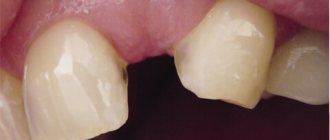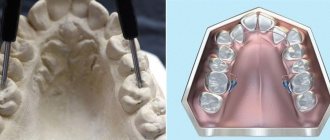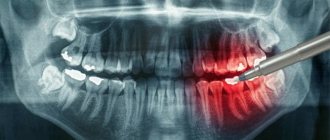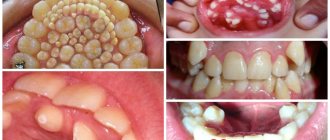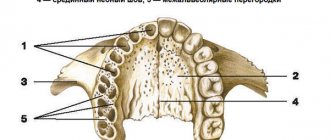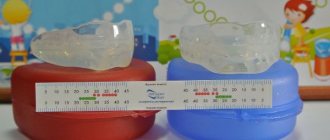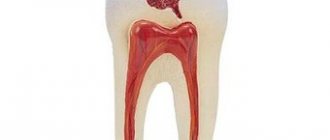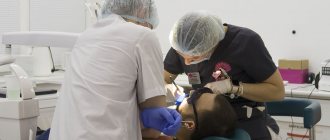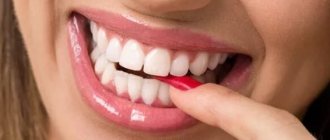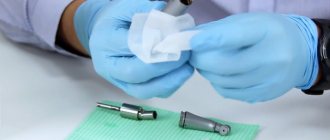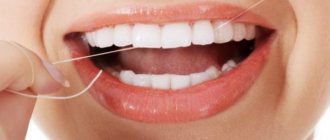Gavrilov’s classification is a clear system of dentition defects with an accessible structure. This combination of elements has proven its practicality in the technique of dental prosthetics.
“A feature of Gavrilov’s classification is the separation of jaws with single preserved teeth into a special group”
A dental arch defect is considered to be a violation of the integrity of a row in which from one to 13 teeth are missing. Three types of defects are identified, in ascending order:
- small defects are characterized by the absence of up to three teeth in a row;
- medium defects - loss of three to six teeth in a row;
- A shortage of more than six pieces is considered large;
Included is a gap in a row of preserved teeth localized on both sides.
End – absence of teeth in the arch, limited only on one side. Both species are found on both the lower and upper jaws.
Why is it necessary to systematize defects in dental arches?
There are a great variety of different combinations of dental defects. For example, if you try to create a mathematical model of these combinations, including all available characteristics and taking into account the combination of various characteristics. As a result, we get at least 4*109 options, each of which has the right to exist. Such a number of variations clearly shows the need to develop generalized classifications. This is more convenient in practical use and allows doctors from different countries to understand each other.
Classification of dentition defects according to Gavrilov
While developing his system of characteristics for dental prosthetics, Professor Gavrilov identified jaws with preserved free-standing teeth as a separate category. This decision is completely justified, since the manufacture of dentures for this type of jaw has its own characteristics.
Dental arches with defects are divided into four classes:
- absence of teeth at the ends of the jaws (end defects) on one or both sides of the jaw;
- defects limited by teeth on both sides (included), anterior and lateral one and two-sided;
- the presence of the first and second classes in various combinations - combined defects;
- dental arches with free-standing teeth.
| One-sided end flaw | Double end flaw |
Additionally, it is proposed to subdivide the dentition into 6 types.
Differences in the classification of dental defects according to Gavrilov
Two classifications are widely used, and.
Kennedy's system of signs has four types:
- terminal defects on both sides of the jaw;
- the same thing, but only on one side;
- included defects in the side area of the rows;
- the same as in the third point, but in the anterior section;
Betelman identifies two categories. The first includes dentition with several flaws, on one or both sides, but there must be at least one “end” defect. The second category is any types and combinations of “included” defects.
There are some challenges to using Dr. Kennedy's system. When diagnosing various combinations that do not fall into its classification, it is proposed to lower the gradation of the class. This can lead to some confusion about the diagnosis.
As can be seen from the three above systems, the classification of dentition according to Gavrilov seems to be the most specific.
In conclusion, it should be noted that none of the systems considered does not provide an accurate picture in relation to a single clinical case. A large number of factors influencing incomplete tooth loss do not allow us to fit them into such a narrow framework
The doctor plans orthopedic treatment individually for each patient, taking into account the number and location of missing teeth, periodontal condition and level of health. But there are still general principles for choosing a prosthesis design depending on the extent and location of the defect. For recording in the chart and professional communication between dentists, it is more convenient to use a symbol of the clinical situation, rather than its full description. The classification of dental defects simplifies the algorithm for choosing a treatment plan and filling out documentation.
Gaps in the dentition
A dental arch defect is considered to be a violation of the integrity of a row in which from one to 13 teeth are missing. Three types of defects are identified, in ascending order:
- small defects are characterized by the absence of up to three teeth in a row;
- medium defects - loss of three to six teeth in a row;
- A shortage of more than six pieces is considered large;
Included is a gap in a row of preserved teeth localized on both sides.
End – absence of teeth in the arch, limited only on one side. Both species are found on both the lower and upper jaws.
Which classification is better?
Classics of orthopedic dentistry - Kennedy classification. In it, dentition defects are divided into 4 classes: one- and two-sided end defects, included in the lateral and frontal areas. At the same time, the absence of several teeth in the lateral area on one side and on both sides must be classified as one class, which in practice is not always convenient. Therefore, some dentists in the clinic use a more detailed classification of Gavrilov. The classes in these systems may not match in number, so when formulating a diagnosis, the doctor must indicate which classification he uses, according to Gavrilov or Kennedy.
Class I – chewing teeth are absent on both sides, the dentition is shortened and ends at the 5th 6th tooth on each side;
Class II – shortening of the dental arch on one side, molars missing on the right or left;
Class III – several teeth are missing in the lateral area, but the trailing ones are preserved;
Class IV – absence of incisors or canines in the anterior part of the jaw.
If there are several isolated defects, a lower class is assigned. For example, if two teeth are missing in the front area and three molars on the right, the defect is classified as first class. In this regard, Kennedy's classification is not entirely convenient. One group includes fundamentally different clinical situations, for which the prosthetic plan will be different.
Class 1 – absence of chewing teeth on the right or left;
Class 2 – loss of distal support of the dentition on both sides;
Class 3 – several chewing teeth are missing and there are closing teeth on one side;
Class 4 – absence of several molars with preservation of distal supports on both sides;
Class 5 – absence of several incisors and/or canines;
Class 6 – combined defects of the dentition;
7th grade – one tooth is retained on the jaw.
The Gavrilov classification is more detailed in comparison with the Kennedy taxonomy and better reflects the clinical situation, therefore, when making a diagnosis, it is easier to plan treatment using it.
According to Kennedy and Gavrilov
II class according to Kennedy – 1 according to Gavrilov
Since there is no distal support, it is impossible to make a permanent bridge, there is simply nothing to fix it to. Previously proposed cantilever structures with an overhanging artificial crown did not stand the test of time. They do not last long and, in addition, lead to loosening and falling out of the support.
The following orthopedic treatment options are possible:
- partial plate removable denture is not fixed well enough and tips over during chewing, since the load falls on one side of the plate;
- The clasp prosthesis, due to the presence of cast clasps and a metal arch, tilts to a lesser extent and acts less aggressively on the supporting teeth;
- prosthetics on implants according to the principle of one tooth - one implant involves the manufacture of a non-removable structure. In this case, chewing efficiency is completely restored and there is no additional stress on the remaining teeth. In the absence of special contraindications, this is the method of choice.
I class according to Kennedy – 2 according to Gavrilov
The same prosthetic options are used as in the previous case. Bilateral end defects differ in that in this case the fixation and function of removable dentures is better due to the uniform distribution of the load on both sides. When choosing a fixed structure, a clasp denture is preferable, especially in the upper jaw. The presence of a metal arc allows you to reduce the size of the plate and leave the sky open.
Fixed prosthetics are possible with the use of implants. If the teeth have been lost for a long time and no treatment has been carried out, the bone tissue may not be enough, but in this case it can be increased using a special operation. With good hygienic skills and the absence of contraindications, the effectiveness of prosthetics on implants in this case is superior to that of removable prosthetics.
III class according to Kennedy – 3 according to Gavrilov
It is possible to restore the defect using both removable and non-removable structures:
- A bridge supported by teeth that limit the defect is a budget option. The advantage is that the design is non-removable, the disadvantage is the increased load on the supporting teeth. Periodontal diseases and mobility of remaining teeth can significantly narrow the indications for such treatment.
- removable clasp denture is a viable prosthetic option, but not entirely comfortable. Firstly, the structure is removable, and secondly, if there is a one-sided defect, the overturning effect will work.
- installation of implants is again leading in terms of comfort and physiology. There is no load on the supporting teeth, there is no need to grind them down to remove healthy tissue, and the chewing function is completely restored.
III class according to Kennedy – 4 according to Gavrilov
The options are the same, but clasp dentures in terms of ease of wear and restoration of function are catching up with fixed structures due to the bilateral uniform distribution of the load.
IV class according to Kennedy – 5 class according to Gavrilov
Removable and bridge dentures may well restore the function of lost teeth, but in order for their fixation to be adequate, it is necessary to use clasps that will be clearly visible on the teeth. But in the anterior section, aesthetics are needed. Bridges, with sufficiently strong support, are functionally satisfactory, but can also compromise aesthetics, especially with atrophy of the alveolar process, when a significant gap forms between the neck of the artificial tooth and the gum.
Implants help completely restore the chewing efficiency and aesthetics of the front teeth. This is the only localization in which installation of an implant simultaneously with tooth extraction is preferable. This creates optimal conditions for healing and prevents loss of gums and bone tissue. The aesthetic result of such structures is beyond competition.
6th grade according to Gavrilov
For combined defects, planning is strictly individual. This option is not reflected in Kennedy's classification.
7th grade according to Gavrilov
This type of dentition defects in the Kennedy classification is classified as bilateral end, while the clinical manifestations and treatment plan in these two cases can differ radically. It was previously proposed to use single teeth as a support for fixing a removable denture, especially in the lower jaw, where the conditions for this, to put it mildly, leave much to be desired. With the advent of implantation, the need to save the last tooth by hook or by crook has disappeared. Prosthetics for single standing teeth, as well as for completely toothless jaws, are carried out using implants.
Changes in the sequence of the dentition may involve disturbances in the continuity and unity of the teeth in the upper or lower jaw, and the reasons for this phenomenon can be completely different. These include injuries, bruises, infectious diseases of the oral cavity, lack of proper treatment for caries, which results in complications.
Included defect in the anterior region
An included defect in the anterior part of the dentition of the upper or lower jaw is a type of edentia, which is classified according to the method of orthopedist E. Kennedy as follows:
- the integrity of only 3, 4, 5, 6, 7 teeth of the chewing group on the right side is preserved;
- only molars 3, 4, 5, 6, 7 are present on the left side;
- 1 and 2 teeth are completely missing on the right and left sides.
A distinctive feature of included adentia in the anterior part of the dental arch is that areas of the jaw apparatus with signs of the absence of molars are located in the smile zone. A person with such a dental pathology is deprived of the opportunity to fully bite off rough food; over time, malocclusion occurs, and the reproduction of vowels and consonants occurs.
Methods for eliminating an included defect in the anterior section
The choice of method for eliminating included adentia in the anterior part of the dental arch of the upper and lower jaw depends on the total number of missing incisors. In such a situation, a bridge-like prosthesis is made, the edges of which are placed on top of the lateral molars. In this case, the supporting teeth are ground by a dentist and contribute to reliable fixation of the prosthesis, simulating the front incisors.
Patients with complicated mixed defects need the production of a volumetric bridge, the structure of which is attached to the posterior lateral teeth, and the missing incisors are located on its metal base. Additional attachments are created on other molars of the oral cavity, the structure of which is not damaged by dental diseases. Depending on the complexity of the metal structure, its main part may come into contact with the surface of the mucous membrane of the hard palate.
Classification of dentition defects according to Kennedy
There are several ways to describe this pathology. The most common is the Kennedy classification. It is based on the following defects:
- first group - the dentition is limited on both sides by the 5th or 6th tooth, with no chewing crowns;
- second group - the dentition is shortened due to the absence of molars on one side or the other;
- third group - the chewing crown is preserved, but there are no teeth in the lateral zone;
- fourth group - the structure of the anterior part of the jaw is disturbed, in particular, there are no fangs or incisors.
If the Kennedy classification is used for diagnosis, orthopedics implies complicated treatment, since if there are several anomalies at once, then the disease is assigned a lower group. Because of this, the prosthetic plan also changes. Different clinical cases may belong to the same group.
Symptoms
Dental defects have their own symptoms. If treatment is not taken on time, this flaw can only get worse. So, let's list the main symptoms:
- difficulty chewing food,
- incorrect bite,
- distortion of the shape of the dental arch,
- problems with pronunciation of words,
- changes in the jaw bones.
Due to unequal pressure on the dental arches, a strong shift occurs: from areas with high load to areas where there is not enough load. As a result, atrophic changes appear.
This deficiency can be corrected only with the help of timely prosthetics. This area of medicine is practiced by orthopedic dentists. Current technologies, treatment methods and high-quality materials will help the patient cope with the problem.
Included defects are identified when a row of teeth remains on both sides of the existing defect, that is, the defects are located in the middle of the dentition. In this option, the doctor places a bridge prosthesis (“bridge”). If the defect is distal, then it is located behind the fangs and is noticeable on one or both sides. Then the defects can actually be replaced with a removable denture.
Causes of dental defects
There are several reasons that lead to the problem (to eliminate them, it is necessary to classify the pathology as a specific group, which is why the Kennedy classification exists):
- Congenital anomalies, in particular edentia (lack of teeth) due to mother's illness during pregnancy, due to which the rudiments of teeth may be absent, there may also be errors in the structure of the enamel, which is inherited.
- Having bad habits. In children, using a pacifier and artificial feeding, sucking fingers; in adults, the habit of cracking nuts, such as pistachios, can lead to tooth loss.
- Caries if left untreated. Regular visits to the dentist will help keep your teeth intact.
- Inflammatory processes. If purulent inflammation occurs, the tooth must be removed immediately. Periodontitis, cysts, periodontitis and other dental diseases can lead to this.
- Mechanical injuries, which is especially important at the age of 6-9 years. During this period, the baby teeth are replaced by molars, and a strong blow can damage the root.
- Children's diseases, such as rickets, pneumonia, acute respiratory diseases that appear during the formation of teeth. They have a negative impact on the structure of the central incisors.
- The presence of a neoplasm in the periodontium. If it is detected, then immediate tooth extraction is necessary. Neoplasms can occur as a result of disruption of the thyroid gland, gastrointestinal tract, and also due to a lack of vitamins.
Symptoms of defects
The Kennedy classification of defects indicates that the problem arises as a result of tooth loss or development. Signs depend on many factors:
- the exact location may be the lateral or front teeth on the lower or upper jaw);
- flaw parameters;
- type of defect (can be included or terminal);
- bite structures;
- patient's age;
- condition of the gums and existing teeth;
- time from the moment of tooth loss to the start of treatment;
- reasons for the defect.
To identify a defect, you need to come to an appointment with a dentist, who will conduct an examination and determine the problem. The main complaints from patients that force people to go to the doctor are:
- malocclusion;
- inability to fully chew food;
- jaw bone deformation;
- in some cases, diction problems.
Elimination of the defect depends on the group of the disease, for which a certain scheme must be used, and the Kennedy classification is most often used. Before prosthetics or implantation, the dentist must carry out professional teeth cleaning, during which they eliminate caries and eliminate any inflammatory processes.
Prevention methods
An adult can independently take measures to prevent the occurrence of defects, which can be diagnosed using the Kennedy classification. The main enemy in this situation is caries, so adequate oral hygiene and regular visits to the dentist are necessary. This also applies to children. Parents may neglect the oral hygiene of a child with baby teeth because they think they will fall out anyway and don't need care. But that's not true. Also, if detected, they must be treated promptly. Ignoring any problems in the oral cavity can aggravate the situation and lead to tooth loss.
This disease is easily recognized by the absence of one or more teeth, which causes discomfort when chewing and talking. Ignoring such violations can negatively affect healthy teeth and lead to a decrease in the volume of bone tissue in the jaw.
It is very important to promptly seek help from a dentist or orthodontist who can provide adequate treatment.
Types of dentition defects - classifications according to Kennedy, according to Gavrilov, according to Betelman
In the most general terms, the dental disease in question can be classified as follows:
- Errors in the structure of the front teeth. This often applies to canines and incisors.
- Defects in the structure of the teeth that are located behind the canines.
- Defects associated with the outermost crowns in the dentition.
- Disadvantages that are present in the anterior + posterior part of the arch.
The most common are the following groups of classifications:
According to Kennedy
Based on the following defects:
- Group
I. _
The length of the dentition on both sides is limited to the 5th or 6th tooth. There are no chewing crowns. - II .
The length of the dental arch is reduced due to the absence of molars on the left/right side. - III group
.
The trailing crowns at the end of the row are preserved, but several teeth are missing in the lateral area. - IV group
.
The front part of the jaw is subject to deformation: there are no fangs/incisors here.
Organizing treatment with this type of classification is not very convenient: if there are several anomalies at once, the disease is assigned a lower group.
This has an effect on the prosthetic plan: completely different clinical cases may belong to an identical group.
According to Gavrilov
This division of defects is quite detailed: it will be easier for the appropriate specialist to decide on the treatment method.
- I class
.
There are flaws at the end of the dental arch: on the right or left. - II class
.
The distal support on the upper/lower jaw is lost on both sides. - III class
.
In the lateral part of the dentition there are no several chewing teeth, but the trailing crown is present. - IV class
.
The distal supports on both sides are preserved, but there are flaws in the lateral sections of the dentition. - V class
.
Several teeth are missing in front of the arch. - VI class
.
There are defects of a combined nature. - VII class
.
There is only one tooth left on the jaw.
According to Betelman
There are 2 classes, each of which has 2 subclasses.
I
class.
Characterized by the presence of the so-called.
terminal defects
, in which chewing teeth, starting from the 5th or 6th, are absent.
Such flaws can be on one side of the arch ( I subclass
) or on both sides (
II subclass
).
II
class
.
Provides for the presence of included defects when there are no crowns in any place in the dental arch.
- I subclass
.
It is diagnosed if there are one or more included defects, and the number of missing teeth from one defect does not exceed three. - II subclass
.
Characterized by the presence of one or more included defects, and at least one defect is missing more than three teeth.
Systematization according to Eichner
A simpler option for dividing abnormal dental development than the previous one. Eichner hypothesized that in the human dental arch there are four so-called protective zones, called molars and premolars for the right and left sides. They are responsible for maintaining the interalveolar height.
In the case of dental defects, they can be divided into three groups:
- first group A - includes rows that have antagonist teeth in all four premolar and molar zones;
- second group B – in some protective zones there are no teeth, this can affect either one zone or several at once;
- third group C – antagonist teeth are lost in all 3 zones.
Causes of dental defects – what role does heredity or poor oral hygiene play?
Various factors can provoke the disease in question:
- Congenital anomalies
.
This, first of all, includes, which can develop against the background of a mother’s illness during pregnancy. The absence of tooth buds, supernumerary teeth, diastema, and errors in the enamel structure can also be inherited. - Bad habits
.
Long-term use of a pacifier, artificial feeding, and finger sucking negatively affect the formation of a bite. Those who like to crack nuts and pistachios should remember the danger of splitting the crown and damaging the root. - Caries
.
In advanced stages of this pathology, patients can lose several teeth at once. Therefore, oral hygiene, regular visits to the dentist, and timely treatment of carious teeth play an important role in keeping the dentition intact. - Septic phenomena that were formed under the influence of purulent inflammation
.
In case of such reactions, the tooth should be removed immediately, and periodontitis, cysts and some other dental ailments can lead to a similar result. - Injuries
.
Loss of teeth due to fights or falls is especially important for boys aged 6-9 years. During this period, children undergo a change of teeth: a strong blow can cause damage to the root, which will stop its development in the future. - Some childhood diseases (rickets, pneumonia, acute respiratory viral infections)
that are diagnosed at the stage of tooth formation. Such pathologies negatively affect the structure of the central incisors. - Neoplasms in the periodontium
that require tooth extraction. They can arise due to errors in the functioning of the thyroid gland, gastrointestinal tract, heart and respiratory system, and with hypovitaminosis.
Preventive measures
How to prevent defects from appearing? Preventive measures are as follows: it is extremely important to monitor oral hygiene, undergo regular dental examinations, immediately respond to defects that have formed and eliminate them in order to prevent further development. The main thing is to take care of your health in a timely manner. However, it is best not to let the situation get to such an extent that you have to remove the tooth. If the defect cannot be cured, then contact a doctor: he will conduct an examination and suggest the best option for dental prosthetics.
Symptoms of dental defects - methods for diagnosing pathology
The manifestations of this pathology will depend on several components:
- The exact location of the defect: lower/upper jaw, lateral/front teeth.
- Flaw parameters.
- Type of defect (on, end).
- Bite structure.
- Patient's age.
- General condition of gums and teeth.
- The amount of time from the moment of tooth loss to the start of treatment.
- Cause of tooth loss/damage.
To identify this disease, instrumental examination is often not required. All you need to do is come to an appointment with a dentist, who during the examination will determine the presence of a defect in the dentition.
The main complaints from the patient will be as follows:
- Errors in bite.
- Inability to chew food normally.
- Deformation of the bone tissue of the jaw.
- Impaired diction (not always).
At the end of the history taking, the dentist may order an x-ray. This will be useful if you need to establish the exact causes of the defect; for a detailed study of the extent of root/bone damage.
Treatment methods for dental defects – restoration and straightening
Based on the class/group of the disease, treatment will also vary:
- In the absence of distal support, the ideal solution would be to install implants (each for one tooth). This will help protect healthy teeth from excessive stress and will have a positive effect on chewing abilities. If the patient has contraindications to this procedure, or does not have enough funds to install implants, doctors opt for a bulge prosthesis.
- If there are no lateral chewing teeth, but there are closing crowns, several types of dental restoration can be used:
- Fixed bridge supported by healthy crowns. The negative point is increased pressure on the supporting teeth. However, this method of treatment is the most optimal in terms of money.
- Use of a removable bulge denture. Not the most comfortable design for the patient, and if a one-sided flaw is being repaired, a tipping effect should be expected.
- Restoration through implantation. The condition of the jaw bone is taken into account here. When it atrophies, it is necessary to first build it up.
- Extensive defects in the dental arch are best restored with nylon dentures. They do not cause allergies, are not noticeable during conversation, and only need to be removed for cleaning.
- It is important to fill the absence of front teeth with ceramic dentures.
- Complex defects are eliminated individually. Here the condition of the jaw, the patient’s financial capabilities, and the presence of concomitant diseases will be taken into account.
Measures to prevent dental defects
- The main enemy of this pathology is carious teeth. The best remedy in this case is adequate oral hygiene.
- This also applies to children whose first teeth have erupted. Parents should take care to purchase a special toothbrush with soft bristles.
- For any injuries that affect the condition of baby teeth, you should immediately contact a pediatric dentist.
- Adults should not ignore annual visits to the dentist - even if there are no complaints. Professional teeth cleaning can only be done in the office of a specialist.
- Malocclusion and supernumerary teeth also need to be treated on time. Ignoring these defects will only make the situation worse over time.
The classification of the patient's dental defects is carried out by the dentist to select treatment. The number of missing teeth, the health of the remaining units, and the condition of the periodontium are taken into account.
Expert opinion
Biryukov Andrey Anatolievich
doctor implantologist orthopedic surgeon Graduated from Crimean Medical University. Institute in 1991. Specialization in therapeutic, surgical and orthopedic dentistry including implantology and implant prosthetics.
I believe that you can still save a lot on visits to the dentist. Of course I'm talking about dental care. After all, if you carefully care for them, then treatment may indeed not come to pass - it won’t be necessary. Microcracks and small caries on teeth can be removed with regular toothpaste. How? The so-called filling paste. For myself, I highlight Denta Seal. Try it too.
There are laws that allow you to select a prosthesis taking into account the extent and location of the disorder. The classification facilitates communication between dental specialists and simplifies documentation.
When is classification needed?
Any of the classification methods makes it easier for the orthodontist to study partial tooth loss, simplifies documentation, and allows doctors to identify the problem during work. However, the widespread classification is not able to provide guidance on the choice of design and cannot reflect a specific picture of disorders, type of occlusion, or tissue health.
Thanks to systematization, the definition of a defect is accelerated, clarified, and the choice of treatment direction is clarified. If you do not take into account the nature of the pathology, you can harm the functionality of your teeth with improper prosthetics.
Then the loads are distributed unevenly, tissues and teeth are overloaded, causing complications. To exclude the development of events, orthodontists systematized pathologies, dividing them into classes and subclasses.
Parameters that allow you to assign a defect to a specific group:
- defects in the structure of the jaw units coming after the canines;
- anomalies in the structure of incisors and canines;
- pathology of the posterior or anterior part of the arch;
- problems with the outermost teeth of the row.
The most common types of systematization are according to Betelman, Kennedy, Gavrilov. Named after the names of the inventors. Not very popular methods - according to Zhulev, Eichner, Oksman.
Why is classification needed?
Since the 19th century, many dentists have been puzzled by the issue of creating a certain classification of all the main types of dentition defects in order to develop universal approaches to their study and the selection of correct and effective methods of therapy.
Classification allows you to quickly and more accurately determine the type of defect present and select the optimal way to treat it, for example, the most suitable prosthesis option in a particular case.
This is a very difficult and important task, since if you do not take into account the nature of the deviation, you can, for example, disrupt the normal functioning of the dentition after prosthetics.
It often happens that after poor-quality orthodontic treatment, the load on the teeth is distributed unevenly and they, as well as the supporting soft tissues nearby, are constantly overloaded, which can cause other problems.
To avoid complications and achieve maximum treatment efficiency, prominent dentists have developed and systematized all orthodontic pathologies into classes and subclasses.
The classifications of dentition defects according to Kennedy, Betelman and Gavrilov are most often used in modern dentistry. Systematizations according to Eichner, Zhulev, Oksman and some other doctors are also popular.
Choosing a dental prosthesis is not an easy task - the varieties are dizzying...
Kennedy classification
American dentist Edward Kennedy was a revolutionary in performing operations designed to eliminate malocclusion. The accumulated experience allowed him in 1921 to develop a classification of the anomalies encountered, identifying 4 classes and 3 subclasses:
- 1 class. Absence of chewing teeth on both sides of the arch. Subclasses distinguish 3 options for the development of the situation. The first - in addition to the absence of molars, one more tooth is missing. Second – molars and teeth are missing in 2 places. The third – apart from the molars, there are no teeth in 3 different places. The main method of treating anomalies of this group is devices with labile fastening;
- 2nd grade. Unilateral defect, loss of distal support. There are 3 subclasses, similar to the previous one. Correction of such defects is carried out with prostheses with palatal fixation (on the side of healthy teeth) and a device with labile fastening (on the area with the defect);
- 3rd grade. Unilateral problem, presence of distal support. The subclasses are the same as above. The optimal prosthesis is a bridge-like removable structure, which is secured with clasps;
- 4th grade. These include clinical situations where the patient does not have front teeth. The problem is eliminated by installing a prosthesis with support clasps.
Subclasses
All of the classes described above, except the last one, also have subclasses that are the same for the three groups:
- the dental unit, in addition to the main one, is missing in one more place;
- no teeth in 2 more places, with the exception of the sides;
- absence of units additional three places, except for the main chewing units located on the sides.
If the dental arch has several defects that belong to different classes, then it is classified into a smaller group. For example, when disorders of the second and third classes are diagnosed in the dentition, the second class is assigned to the arch defect.
There are also many other classifications in dental practice that are less common and not as popular as the Kennedy method. This is explained by the fact that the system he proposed fulfills its main task well, which is to select a more optimal orthodontic design for the treatment of the most common defects of the dentofacial apparatus.
The use of such techniques allows dentists to significantly simplify their work and the life of the patient. In addition, thanks to this method, it becomes possible to choose the most suitable and effective option for attaching the prosthesis used, which allows you to take into account the anatomical features of each patient individually as accurately as possible.
Gavrilov system
E.I. Gavrilov is a Doctor of Medical Sciences, a prominent scientific figure of the Soviet Union. His goal was not only to restore aesthetics to the dentition, but also to restore functionality and distribute the load over all areas of the jaw. The systematization developed by Gavrilov defines a detailed description of the problem, which helps the doctor determine a treatment regimen. The scientist systematized the problems into 7 groups.
Do you feel nervous before visiting the dentist?
Not really
I class. This includes defects on the right and left sides of the end of the dental arch.
Treatment options:
- clasp denture with cast clasps gently acts on the teeth that serve as support;
- removable partial plate denture. There are disadvantages - weak fixation, the likelihood of tipping over while eating due to one-sided load;
- prosthetics with implants - a fixed prosthesis that restores the functionality of the jaws without stress. If there are no contraindications, then this option is considered the best.
II class. This group includes defects when the distal support of one of the jaws is lost. Prosthetic options are selected similarly to the conditions. The bilateral presence of problems at the ends of the jaws ensures fixation of the removable denture, the load is evenly distributed along the row. When choosing designs, they choose a clasp denture when it comes to problems of the upper jaw. Thanks to the metal arc, it is possible to reduce the dimensions of the plate, and the sky remains open.
For conditions belonging to this group, you can choose fixed prosthetics. This method of restoring the functionality of the jaw is acceptable when installing implants. For situations where teeth have long been lost and there has been no treatment, bone deficiency becomes a sign. Technologies make it possible to carry out an operation to increase it. If there are no contraindications and hygiene skills are satisfactory, then prosthetics with implants will be an effective solution to the problem than removable structures.
III class. This group includes defects accompanied by the absence of molars, provided that the extreme molar is preserved.
The dentition can be restored with removable, fixed dentures of the following types:
- removable clasp prosthesis. A good option, but not comfortable. The disadvantages are due to the fact that the structure is removable, and with a one-sided effect it overturns;
- a bridge-like structure, one of the supports of which is fixed on the chewing tooth. This is an inexpensive prosthetic option. The advantages of the method include the reliability of fixation, the disadvantages are the load on the supports. Contraindications to choosing a bridge include periodontal disease and mobility of dental units;
- Implantation occupies a leading position. This method provides maximum comfort and physiology identical to natural. The load on the supporting teeth is eliminated, healthy tissues do not need to be ground down, but chewing and aesthetic functions are completely restored.
IV class. This group includes conditions when the side sections have flaws, but the distal supports are preserved. Options for eliminating the problem are similar to those indicated above, but clasp dentures no longer have any disadvantages, since here the load is evenly distributed over all teeth.
V class. Includes conditions in which several units are missing from the front of the soul. Bridges and removable dentures will help restore the dentition. To ensure reliable fixation, clasps are used. Such fastenings are noticeable on the teeth, so the aesthetics will not be up to par. Considering that we are talking about teeth involved in a smile, this method of treatment should not be preferred. Bridges, if they have strong supports, provide excellent functionality, but they look unsightly, especially if there is a gap between the gum and the neck of the artificial crown.
Unlike previous treatment methods, implants have virtually no disadvantages (except for price). They are able to restore lost aesthetics and chewing function. One-stage implantation becomes preferable, in which the tooth is removed and an artificial root is immediately installed in its place. This allows you to preserve the shape of the gums, the amount of jaw bone tissue, and creates optimal conditions for wound healing. The result obtained in terms of aesthetic indicators has no equal.
VI grade. This includes combined defects. Planning is carried out taking into account the identified problems.
VII class. The last group includes all pathologies in which there is only one tooth left in the mouth.
Systematization according to Gavrilov is used by orthodontists; it allows choosing the optimal design for prosthetics in a wide variety of conditions. Then single teeth were used as support for removable dentures. This practice was widespread in relation to problems of the lower jaw.
Thanks to implantation, there is no longer a need to save a tooth if there is little reason to do so. Implants can become a support for various orthodontic structures in the presence of single teeth or complete edentia.
Betelmann classification
Betelman developed a type of systematization that allows you to select a denture for dental problems. Its classification involves dividing deviations into 2 classes, each with 2 subclasses.
I class. They include conditions when end defects are detected (no molars, starting from the 5th or 6th unit to the end of the jaw). If the problems are localized on one side of the arch, they are classified as subclass I, if on both sides - to subclass II.
II class. This group of dental problems includes the absence of crowns anywhere in the dental arch. There are 2 subclasses:
- Conditions in which 1 or more included defects are detected, with one problem area including up to 3 missing units.
- The presence of 1 or more included defects, and the defect includes more than 3 missing units.
Betelmann classes and subclasses
Dentist Betelman proposed his own method for determining the necessary prostheses for installation for certain defects. He divided all dentofacial deviations into two large groups, each of which in turn consists of two subclasses.
The Betelman classification looks like this:
- First class - there are defects in the dentition with one or several terminal defects. This means that the problem teeth are at the ends of the rows. Accordingly, there are two subclasses: 1st subclass - only one-sided end defect is present in the row, 2nd subclass - the patient has bilateral end defects.
- Second class – included defects, one or more, are observed. Included means that the end teeth are in place, but those located in other parts of the row are missing. 1 subclass of the 2nd class indicates the presence of one or more included defects, in which no more than three adjacent teeth are missing; Subclass 2 includes defects in which there is one or more damage extending over 3 or more dental units.
This approach is simpler than that of Kennedy, but it systematizes well the typical deviations in the structure of the dental system.
Zhulev classification
E.N. Zhulev is a professor, representative of the Medical Academy of N. Novgorod. Zhulev will present a systematization of dental problems in 1989. The essence comes down to the distribution of pathologies into 5 groups (classes):
- Pits, depressions, cavities in fissures.
- Pits on the incisors, cavities in the fissures.
- Cavities on the surface of the incisors and lateral teeth.
- Cavities in the gingival, cervical area.
- Combined anomalies, including the symptoms indicated above.
In addition to those listed, there are well-known systematizations of dentition defects, but they are used less frequently.
Features of the Zhulev system
Zhulev E.N. is a representative of the Nizhny Novgorod Medical Academy, a professor who in 1989 put forward his own version of the systematization of dentofacial abnormalities. His system consists of five classes:
- Class 1 – cavities, various types of depressions and pits that appear in the fissures;
- Class 2 – cavities that have appeared in the fissures, as well as the pits of the front teeth;
- Class 3 – cavities present on the surface of any front or lateral tooth;
- Class 4 – cavities in the cervical or gingival region;
- Class 5 – combined cases, including mixed variants from the previous specified problems.
There are many other, less well-known classifications by class, but they are used quite rarely, since the above systems of Kennedy, Gavrilov and some other doctors cope quite well with the task at hand - choosing the most suitable prosthesis for typical, frequently occurring dental defects.
Using such systems, dentists make life much easier for themselves and the patient and can choose the most optimal version of the prosthesis to be installed, which will take into account the anatomical characteristics of a particular person to the maximum.
Of course, each case is unique and it is not easy to predict all possible original combinations of deviations, but in most cases, these classification systems solve the tasks assigned to dentists quite well.
